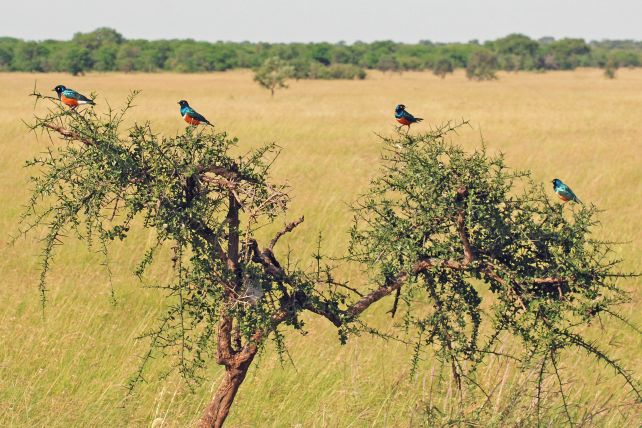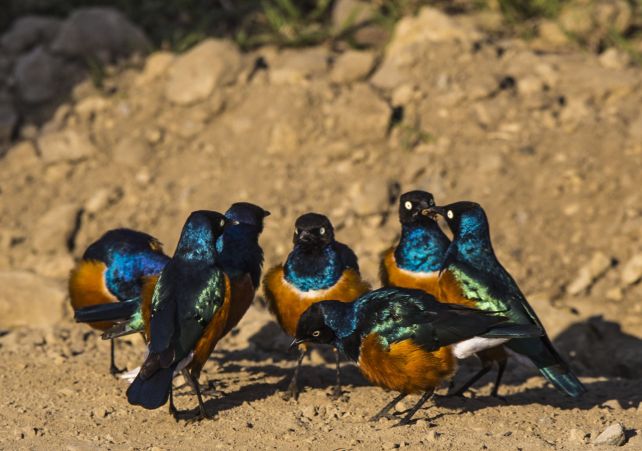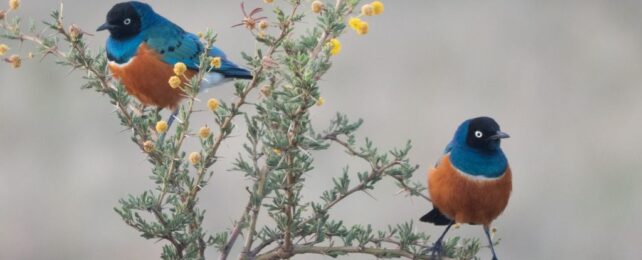The ability to cooperate and work together is not unique to humans; indeed, it's one of the most successful strategies for collective survival in the whole tree of life, from the give-and-take between symbionts, to the kindness of strangers in the street.
Friendship – strong and lasting social bonds between unrelated members of the same species – can be a part of that cooperative behavior. It can be pretty hard to confidently identify in non-human animals, but scientists have just discovered something that looks a heck of a lot like it in birds.
More than 20 years of data on superb starlings (Lamprotornis superbus), analyzed by a team led by biologist Alexis Earl of Cornell University, reveals clear examples of reciprocal helping: offering assistance to unrelated members of the flock, with the expectation that the favor will be returned.
"This is the first real evidence of reciprocity in a cooperatively breeding bird," ornithologist Dustin Rubenstein of Cornell University told ScienceAlert, "and one of the strongest pieces of evidence for reciprocity occurring outside of humans."

For social animals that live their lives in large communities, cooperative behavior is necessary. It's common to see animals with familial ties giving each other assistance, but some animals take it a step further.
Cows, for instance, have unrelated companions whose company they seem to favor. Male dolphins may form social bonds based on shared skills. Vampire bats demonstrate reciprocal food-sharing. And, of course, non-human primates forge social bonds. Non-familial social behavior has even been observed in rooks.
"What we really have here are reciprocal social relationships," Rubenstein explained. "In other words, I might help you today and you might then help me at some point in the future. Both individuals benefit from these long-term reciprocal helping relationships. Because they often occur among unrelated individuals, you might think of them as you do a friendship."
Identifying these relationships in wild animals, however, is not very easy to do. The team's work was based on observations collected on wild starlings of eastern Africa, a bird whose flocks consist of between seven and 60 members.
These birds are known as cooperative breeders, where non-parents help to raise the youngsters. The data, collected between 2002 and 2021, cover nine flocks and 40 breeding seasons.
To contextualize the observational data, the researchers also collected DNA from some of the birds to determine the genetic relationships between them.
From the observational data, the researchers cataloged instances of assistance, when the birds were seen either bringing food to a nest, or helping to defend a nest. They then identified the individuals involved in the assistance.
Unsurprisingly, most of the reciprocal helping occurred between related individuals. But reciprocal helping was by no means limited to family groups within the flock.

"Other starlings, typically immigrants who come into the group, form these strong social relationships with unrelated individuals and reciprocate helping over time," Rubenstein said. "These immigrants don't have relatives with whom they could help breed, so they have to form new social relationships upon joining the group."
This finding challenges the assumption that birds help each other with their parental responsibilities purely out of altruism due to kin selection, the researchers say. Even when relatives are available to help out, some non-related birds help each other, swapping the parent and helper roles from breeding season to breeding season.
In fact, Rubenstein noted, the birds even seem to form close bonds with just a few other specific individuals, suggesting that the relationships are not random, but chosen deliberately. We probably can't go so far as to call them besties – as doing so might be anthropomorphizing – but it's not entirely dissimilar, either.
"I think this study tells us that birds cooperate for many different reasons. Starlings need to have helpers to raise offspring. They can recruit relatives, who both benefit from the genes they share with the offspring, or they can recruit unrelated individuals by forming long-term social bonds," Rubenstein says.
"These might be considered analogous to forming a friendship."
The research has been published in Nature.
